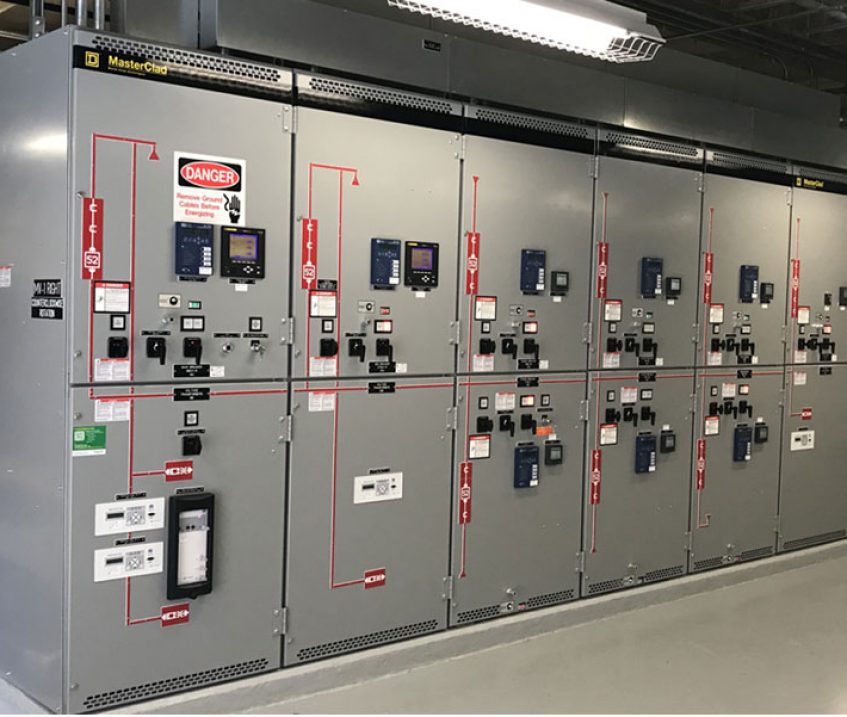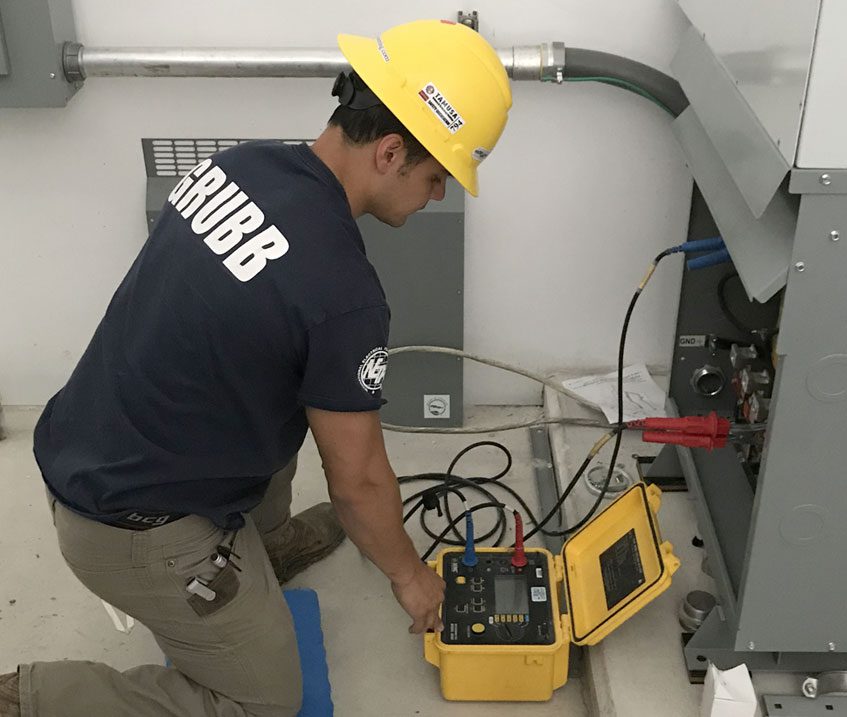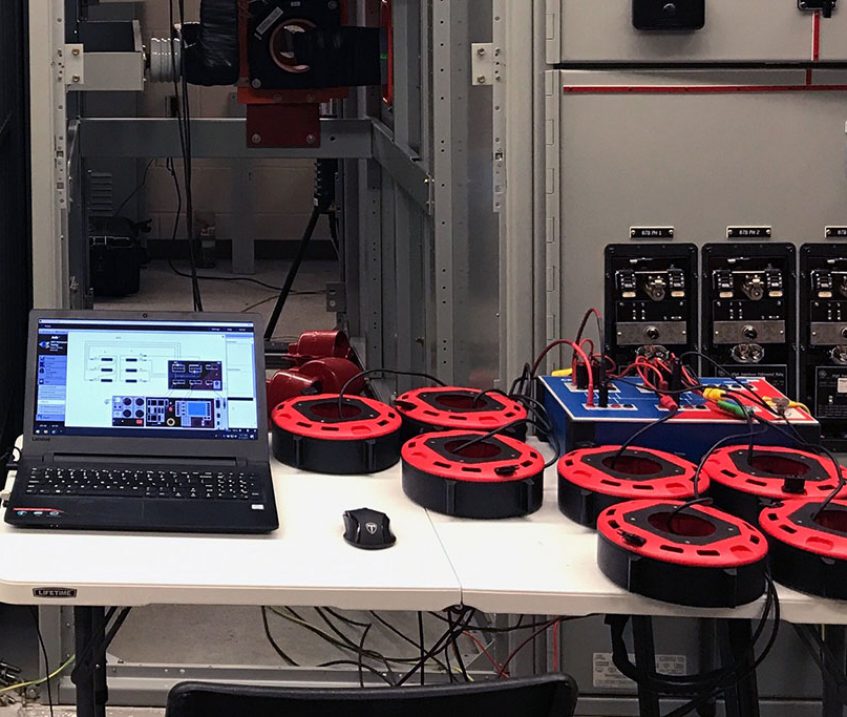GEI offers a wide range of transformer testing including Power Factor, Ultrasonic, PD (Partial Discharge) and oil and gas analysis. Typical transformer testing includes Overall Power Factor and Capacitance, Exciting Current, Leakage Reactance, Transformer Turns Ratio, and DC Winding Resistance. Ultrasonic and PD testing is performed while the transformer is energized, and can detect possible issues before they fail. These tests are crucial for clients who wish to perform testing but cannot afford to take a complete outage for typical power factor testing. Oil and gas analysis is key in detecting moisture content and insulation quality inside the transformer.
Testing of medium voltage cables has come a long way since the days of DC Hipot testing. While GEI still offers DC Hipot testing as an option, newer technologies are now available that can better assess the integrity of your cable. VLF (Very Low Frequency) with Tan Delta technology is an AC testing method that is non-destructive and gives baseline data for new cables that can be compared year after year as an indication of the health of the cable. PD (Partial Discharge) testing can be performed on energized or de-energized cables. Testing on energized cables can give an overall estimated life of the cable, while PD testing of de-energized cables can pinpoint locations of failure before there is a fault.
Cables in conduits, raceways or manholes can be identified allowing them to be easily labeled for maintenance or future work. Cable tracing can be completed on de-energized or energized cables, allowing for identification prior to maintenance work to be completed. A well identified cable infrastructure provides for a safer work environment when multiple feeder circuits are occupying a conduit, raceway, or manhole.
GEI performs acceptance and maintenance testing on all manufacturers of medium voltage switchgear and circuit breakers. Switchgear testing includes current transformers, potential transformers, control power transformers, protective relays, capacitors, snubbers, arrestors and thermal infrared scans. Circuit breaker testing consists of insulation resistance, contact resistance, vacuum bottle testing, dielectric withstand and MAC (Magnetron atmospheric condition) test.
GEI has the ability to test and calibrate any protective relay from simple electro-mechanical 50/51 relays, to the newest solid state relays that require programing with an external laptop computer. With the use of an Omicron CMC356 relay test set, relays can be fully function tested to ensure all protective settings are working properly.
Ultrasonic and TEV (Transient Earth Voltage) testing are newer technologies that detect PD (Partial Discharge) in energized medium voltage equipment, allowing companies a tool, to partly assess the integrity of their switchgear without having to take costly outages.
GEI can perform acceptance testing and maintenance on a variety of pad mounted medium voltage switches. Tests include insulation resistance, contact resistance, dielectric withstand and vacuum integrity.
GEI keeps Nitrogen and SF6 gas on hand and can fill any type of switch or transformer. GEI also has the equipment to detect SF6 gas leaks, and in most cases can make repairs on site.


Testing of low voltage cables will ensure there are no faults or possible points of failure in the insulation of the cables prior to energizing.
GEI performs acceptance and maintenance testing on all brands of auto transfer switches, as well as periodic preventative maintenance and function testing. Testing and maintenance of your facility’s auto transfer switches will ensure proper operation in the case of an unplanned power outage.
GEI has the equipment and experience to test, maintain and repair all makes and types of low voltage circuit breakers, from small molded cases circuit breakers to insulated case and low voltage power circuit breakers. GEI has the ability to test all circuit breakers using primary current up to 60,000 amps, or by using secondary injection test units on select styles of breakers that utilize solid state trip units.
Low voltage motor testing consists of a Polarization Index (PI) test that gauges the integrity of the insulation in the windings of the motor, as well as a winding resistance test to check for any inconsistencies in the windings of the motor.
If your facility’s circuit breakers or switchgear have become outdated, but a full replacement of equipment is not feasible, GEI can assist in getting up to date equipment to work with your existing gear. From a simple upgrade of trip units to allow for communication, to full fabrication of bus and internal components to allow for the addition of new switchgear sections or breakers, Grubb can help accommodate almost any need.
GEI performs acceptance and maintenance testing on all types and sizes of low voltage transformers. Testing on low voltage transformers includes insulation resistance, winding resistance and transformer turns ration testing.
Whether you have new switchgear that needs testing, or existing gear that is due for preventative maintenance, Grubb can ensure your equipment is safe, clean, reliable and functioning properly. All components of switchgear can be tested, including CT’s, PT’s, arrestors, battery strings, power meters and any other components your particular switchgear may utilize.
On top of basic testing and maintenance, GEI can commission your new equipment to ensure all controls and metering are working properly, as well as perform infrared scans during initial load bank testing.
GEI can test, maintain or troubleshoot all types and sizes of current transformers, potential transformers or control power transformers.
Field testing of panelboards and switchboards after installation can ensure there are no deficiencies present before energizing equipment.
Thermal infrared scanning is one of the most valuable preventative maintenance options a facility can do. Thermal scanning is non-invasive, does not require any shutdowns and can provide valuable information about possible deficiencies before they become a catastrophic failure. GEI has a number of level 1 and level 2 certified technicians that are trained in what to look for in all types of electrical equipment. Grubb uses state of the art FLIR cameras to provide detailed images and reports for clients to ensure any issues found are clearly documented and can be addressed in a timely manner.
Whether you are looking for simple power consumption monitoring to determine equipment load, or are experiencing power quality inconsistencies, GEI can determine the equipment needed to capture the data you are looking for. Grubb has experienced engineers that can analyze data collected and provide detailed reports and recommendations on findings.
GEI can provide a wide range of ground testing including Fall-of-Potential, Point to Point and ground resistivity. Fall-of-Potential testing ensures your electrical system meets the minimum requirements for its actual resistance to true earth. Point to point testing verifies that equipment throughout your system is properly bonded to the system ground. Ground resistivity testing is a valuable tool for determining the type of ground grid that will be needed for a particular soil type and location.
GEI has the ability to visually inspect 2” or larger conduits up to 400’ in length. A specifically designed camera can be pushed or pulled through a conduit displaying a high resolution color video showing any blockages or damage to the pipes. A distance measurement, as well as a built-in locator sonde, allows for the location of the buried conduits so that breaks or blockages can be pinpointed and repaired.
In addition to computer run radio path studies, GEI can perform physical radio path studies that mimic actual real world radio locations to verify a new location will be able to communicate with an existing repeater site or access point. Computer run studies only take into account geographical data and are not always representative of actual signal loss due to foliage and man-made structures that can block a radio’s signal.
GEI can provide load bank testing on equipment as small as 120V panelboards, up to full lineups of switchgear. Load bank testing is the ideal testing method to ensure equipment is going to perform properly, and also allows for thermal infrared scanning on equipment that may otherwise not have enough load for poor connections to be found.
GEI provides testing and certification for hospitals and health care facilities for their Line Isolation Transformer panels as well as receptacle grounding in patient care rooms. All testing complies with the latest version of NFPA-99 codes.
GEI can perform maintenance shutdowns on any size gear from low voltage distribution boards up to medium voltage power substations. Maintenance shutdowns are crucial for ensuring your electrical switchgear is clean and operating as it was intended. Circuit breakers that are not maintained properly can fail to operate and cause catastrophic failures and deadly arc flash incidents. Maintenance shutdowns can consist of a simple cleaning and torqueing of bolted connections, to full line testing of all components and cabling in the switchgear.





